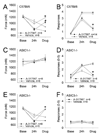ASIC1 and ASIC3 play different roles in the development of Hyperalgesia after inflammatory muscle injury
- PMID: 20015700
- PMCID: PMC2943154
- DOI: 10.1016/j.jpain.2009.07.004
ASIC1 and ASIC3 play different roles in the development of Hyperalgesia after inflammatory muscle injury
Abstract
Acid-sensing ion channels (ASICs) respond to acidosis that normally occurs after inflammation. We examined the expression of ASIC1, ASIC2, and ASIC3 mRNAs in lumbar dorsal root ganglion neurons before and 24 hours after carrageenan-induced muscle inflammation. Muscle inflammation causes bilateral increases of ASIC2 and ASIC3 but not ASIC1 (neither ASIC1a nor ASIC1b) mRNA, suggesting differential regulation of ASIC1 versus ASIC2 and ASIC3 mRNA. Similar mRNA increases were observed after inflammation in knockout mice: ASIC2 mRNA increases in ASIC3-/- mice; ASIC2 and ASIC3 mRNAs increase in ASIC1-/- mice. Prior behavioral studies in ASIC3-/- mice showed deficits in secondary hyperalgesia (increased response to noxious stimuli outside the site of injury) but not primary hyperalgesia (increased response to noxious stimuli at the site of injury). In this study, we show that ASIC1-/- mice do not develop primary muscle hyperalgesia but develop secondary paw hyperalgesia. In contrast, and as expected, ASIC3-/- mice develop primary muscle hyperalgesia but do not develop secondary paw hyperalgesia. The pharmacological utility of the nonselective ASIC inhibitor A-317567, given locally, was tested. A-317567 reverses both the primary and the secondary hyperalgesia induced by carrageenan muscle inflammation. Thus, peripherally located ASIC1 and ASIC3 play different roles in the development of hyperalgesia after muscle inflammation.
Perspective: This study shows changes in ASIC mRNA expression and behavioral hyperalgesia of C57Bl/6 (wild type), ASIC1-/-, and ASIC3-/- mice before and after the induction of muscle inflammation. A-317567 was effective in reversing hyperalgesia in these animals, suggesting the potential of ASICs as therapeutic targets for muscle inflammatory pain.
Copyright 2010 American Pain Society. Published by Elsevier Inc. All rights reserved.
Figures




Similar articles
-
Chronic hyperalgesia induced by repeated acid injections in muscle is abolished by the loss of ASIC3, but not ASIC1.Pain. 2003 Dec;106(3):229-239. doi: 10.1016/S0304-3959(03)00269-0. Pain. 2003. PMID: 14659506
-
Localization and comparative analysis of acid-sensing ion channel (ASIC1, 2, and 3) mRNA expression in mouse colonic sensory neurons within thoracolumbar dorsal root ganglia.J Comp Neurol. 2007 Feb 10;500(5):863-75. doi: 10.1002/cne.21204. J Comp Neurol. 2007. PMID: 17177258
-
Mice lacking acid-sensing ion channels (ASIC) 1 or 2, but not ASIC3, show increased pain behaviour in the formalin test.Eur J Pain. 2009 Jul;13(6):554-63. doi: 10.1016/j.ejpain.2008.07.001. Epub 2008 Sep 17. Eur J Pain. 2009. PMID: 18801682
-
Acid-sensing ion channels (ASICs): pharmacology and implication in pain.Pharmacol Ther. 2010 Dec;128(3):549-58. doi: 10.1016/j.pharmthera.2010.08.006. Epub 2010 Aug 31. Pharmacol Ther. 2010. PMID: 20807551 Review.
-
[Acid-Sensing Ion Channels (ASICs) in pain].Biol Aujourdhui. 2014;208(1):13-20. doi: 10.1051/jbio/2014001. Epub 2014 Jun 23. Biol Aujourdhui. 2014. PMID: 24948015 Review. French.
Cited by
-
Inhibition of human acid-sensing ion channel 1b by zinc.Int J Physiol Pathophysiol Pharmacol. 2012;4(2):84-93. Epub 2012 Jun 20. Int J Physiol Pathophysiol Pharmacol. 2012. PMID: 22837807 Free PMC article.
-
Acid-sensing ion channels (ASICs): therapeutic targets for neurological diseases and their regulation.BMB Rep. 2013 Jun;46(6):295-304. doi: 10.5483/bmbrep.2013.46.6.121. BMB Rep. 2013. PMID: 23790972 Free PMC article. Review.
-
Attenuation of TRPV1 and TRPV4 Expression and Function in Mouse Inflammatory Pain Models Using Electroacupuncture.Evid Based Complement Alternat Med. 2012;2012:636848. doi: 10.1155/2012/636848. Epub 2012 Nov 13. Evid Based Complement Alternat Med. 2012. PMID: 23258994 Free PMC article.
-
Acid-Sensing Ion Channels and Pain.Pharmaceuticals (Basel). 2010 May 11;3(5):1411-1425. doi: 10.3390/ph3051411. Pharmaceuticals (Basel). 2010. PMID: 27713310 Free PMC article. Review.
-
Dual Modulation of Nociception and Cardiovascular Reflexes during Peripheral Ischemia through P2Y1 Receptor-Dependent Sensitization of Muscle Afferents.J Neurosci. 2016 Jan 6;36(1):19-30. doi: 10.1523/JNEUROSCI.2856-15.2016. J Neurosci. 2016. PMID: 26740646 Free PMC article.
References
-
- Akopian AN, Chen CC, Ding Y, Cesare P, Wood JN. A new member of the acid-sensing ion channel family. Neuroreport. 2000;11:2217–2222. - PubMed
-
- Askwith CC, Cheng C, Ikuma M, Benson C, Price MP, Welsh MJ. Neuropeptide FF and FMRFamide potentiate acid-evoked currents from sensory neurons and proton-gated DEG/ENaC channels. Neuron. 2000;26:133–141. - PubMed
-
- Askwith CC, Wemmie JA, Price MP, Rokhlina T, Welsh MJ. Acid-sensing ion channel 2 (ASIC2) modulates ASIC1 H+-activated currents in hippocampal neurons. J Biol Chem. 2004;279:18296–18305. - PubMed
Publication types
MeSH terms
Substances
Grants and funding
LinkOut - more resources
Full Text Sources
Other Literature Sources
Medical

